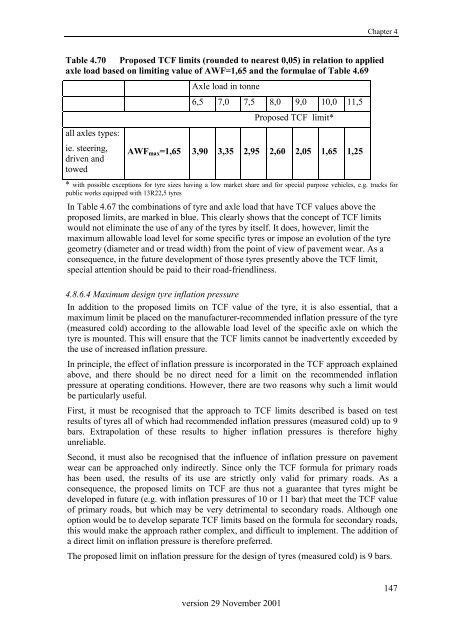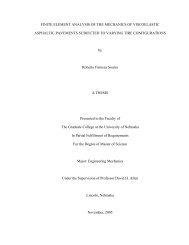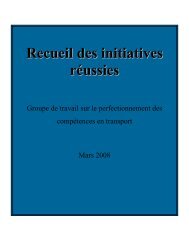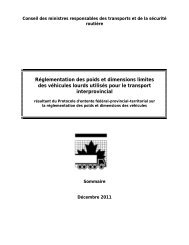Create successful ePaper yourself
Turn your PDF publications into a flip-book with our unique Google optimized e-Paper software.
Chapter 4Table 4.70 Proposed TCF limits (rounded to nearest 0,05) in relation to appliedaxle load based on limiting value of AWF=1,65 and the formulae of Table 4.69Axle load in tonne6,5 7,0 7,5 8,0 9,0 10,0 11,5Proposed TCF limit*all axles types:ie. steering,driven andtowedAWF max =1,65 3,90 3,35 2,95 2,60 2,05 1,65 1,25* with possible exceptions for tyre sizes having a low market share and for special purpose vehicles, e.g. trucks forpublic works equipped with 13R22,5 tyresIn Table 4.67 the combinations of tyre and axle load that have TCF values above theproposed limits, are marked in blue. This clearly shows that the concept of TCF limitswould not eliminate the use of any of the tyres by itself. It does, however, limit themaximum allowable load level for some specific tyres or impose an evolution of the tyregeometry (diameter and or tread width) from the point of view of pavement wear. As aconsequence, in the future development of those tyres presently above the TCF limit,special attention should be paid to their road-friendliness.4.8.6.4 Maximum design tyre inflation pressureIn addition to the proposed limits on TCF value of the tyre, it is also essential, that amaximum limit be placed on the manufacturer-recommended inflation pressure of the tyre(measured cold) according to the allowable load level of the specific axle on which thetyre is mounted. This will ensure that the TCF limits cannot be inadvertently exceeded bythe use of increased inflation pressure.In principle, the effect of inflation pressure is incorporated in the TCF approach explainedabove, and there should be no direct need for a limit on the recommended inflationpressure at operating conditions. However, there are two reasons why such a limit wouldbe particularly useful.First, it must be recognised that the approach to TCF limits described is based on testresults of tyres all of which had recommended inflation pressures (measured cold) up to 9bars. Extrapolation of these results to higher inflation pressures is therefore highyunreliable.Second, it must also be recognised that the influence of inflation pressure on pavementwear can be approached only indirectly. Since only the TCF formula for primary roadshas been used, the results of its use are strictly only valid for primary roads. As aconsequence, the proposed limits on TCF are thus not a guarantee that tyres might bedeveloped in future (e.g. with inflation pressures of 10 or 11 bar) that meet the TCF valueof primary roads, but which may be very detrimental to secondary roads. Although oneoption would be to develop separate TCF limits based on the formula for secondary roads,this would make the approach rather complex, and difficult to implement. The addition ofa direct limit on inflation pressure is therefore preferred.The proposed limit on inflation pressure for the design of tyres (measured cold) is 9 bars.version 29 November 2001147






